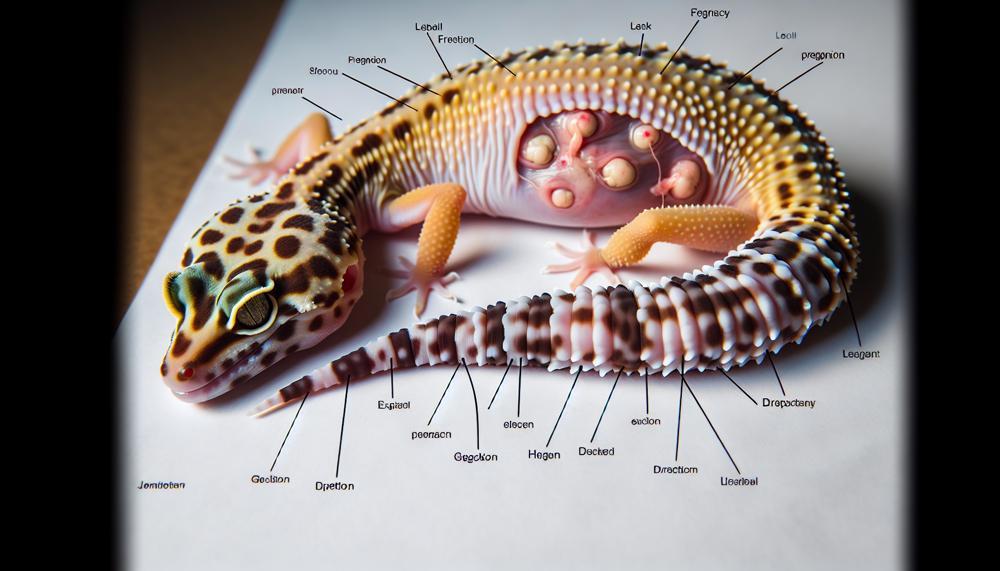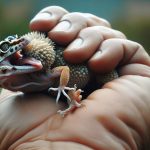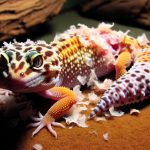If you share your home with one of these charming reptiles, understanding their breeding behavior can be both an intriguing and rewarding aspect of pet ownership. But how do you tell if your scaly friend is expecting? This article is your guide to decoding the often-missed signs of a gravid leopard gecko.
Here, we’ll glide through the key indicators that suggest your leopard gecko may be carrying eggs:
- Physical Transformation: We’ll explore how a leopard gecko’s body morphs in response to pregnancy, from weight gain to the emergence of telltale bulges.
- Behavioral Shifts: Learn to read the silent language of your gecko’s behavior as we decipher what those changes in appetite and activity might mean.
- Habitat Hints: Your gecko’s environment plays a part in her pregnancy journey. We’ll discuss how she interacts with her surroundings and what modifications you might notice.
- Health and Care: Keeping a gravid gecko healthy is paramount. We’ll provide tips on supporting your pet through this phase, ensuring she—and her potential offspring—thrive.
Whether you’re a seasoned gecko guardian or a curious newcomer, this guide will equip you with the knowledge to spot the signs of pregnancy in your leopard gecko, enhancing your connection with these fascinating creatures and preparing you for the possibility of tiny new additions to your reptilian family. Let’s get started on this exciting journey of discovery.
Contents
10 Signs Your Leopard Gecko Is Pregnant
| Sign | Description | Indications |
|---|---|---|
| Bulging Abdomen | The gecko’s belly appears more rounded and distended. | A visual cue of eggs growing within. |
| Diminished Appetite | Showing less interest in food. | Energy conservation for egg development. |
| Weight Gain | Increase in body mass. | Due to eggs’ presence and possible reduced activity. |
| Restlessness | Increased activity levels and agitation. | Behavioral response to hormonal changes and discomfort. |
| Nesting Behavior | More frequent digging or burrowing. | Instinctual preparation for laying eggs. |
| Swollen Cloaca | Enlarged base of the tail. | Physical change indicating reproductive readiness. |
| Pale Skin Patches | Lighter areas on skin appear. | Hormonal alteration affecting pigmentation. |
| Lethargy | More time spent basking or resting. | Energy preservation for the eggs’ growth. |
| Elevated Body Temperature | Body warmth slightly above normal. | Biological adjustment to aid egg development. |
| Visible Eggs | Eggs discernible through the abdomen wall. | Direct indication of imminent egg-laying. |
These signs are vital clues to your leopard gecko’s reproductive status. If you spot these, it’s time to ensure she has a stress-free environment and proper nutrition. Seek advice from a vet specialising in reptiles for bespoke care instructions.
Remember, your gecko’s behaviour and physical state are the best indicators of her health during this critical phase.
What to Do After You Find Out
Upon spotting clues that your leopard gecko might be gravid, act promptly to ensure her well-being and the success of her progeny.
Confirm the Pregnancy
Book an appointment with a reptile vet for a thorough check-up to confirm the gravid status.
Nutritional Support
Ramp up her diet with calcium supplements and a smorgasbord of gut-loaded insects to meet heightened nutritional demands.
Nesting Box Preparation
| Item | Description | Setup Time |
| Nesting Box | A secure container with moist soil or vermiculite, allowing for a comfortable egg-laying environment. | Set up at least two weeks prior to the expected laying date. |
Monitoring and Assistance

Keep a watchful eye on her as the egg-laying nears, and seek veterinary help if she shows signs of distress.
Incubating the Eggs
After egg deposition, gently place them in an incubator tagged with the laying date and maternal details. Maintain optimal conditions for 45-60 days until hatching.
During this critical period, it’s key to keep her habitat stress-free and observe any changes in behaviour or appetite. Address any signs of a calcium deficit immediately to fend off health issues. Remember, a cosy, humid hide will be her sanctuary for egg-laying, so ensure it’s well-prepared. Post-laying, her body will need recovery support, so continue with the enhanced diet and monitor her for any signs of post-oviposition issues.
A gravid leopard gecko entails not just anticipation but also the responsibility of delivering a secure breeding cycle.
Once They’re Separated
Separating a pregnant leopard gecko from her tank-mates is a critical step to ensure her tranquility and the safety of her future hatchlings. Here’s a precise guide to ensure a smooth transition:
| Step | Action | Detail |
| 1 | Confirm Pregnancy | Seek professional advice or observe physical signs |
| 2 | Prepare Separate Enclosure | Replicate original habitat conditions |
| 3 | Gentle Transfer | Move the gecko with minimal stress |
| 4 | Tailor Nutrition | Supplement diet with calcium and vitamins |
| 5 | Nesting Box | Include a secure and moist area for egg-laying |
| 6 | Minimize Disturbances | Keep the enclosure in a tranquil location |
| 7 | Regular Observation | Monitor for egg-laying and general health |
| 8 | Post-Laying Care | Incubate eggs and consider returning the mother to her habitat |
Remember, lass, a gravid gecko’s needs are paramount; handle her with care, akin to holding a delicate treasure. Keep disturbances to a bare minimum, as stress can be as unwelcome as rain on a picnic.
After the Eggs Have Hatched
To discern if your female leopard gecko has laid her eggs, observe her behavior and physical appearance post-mating. A gravid (pregnant) gecko will exhibit a fuller abdomen due to the eggs. Once laid, her belly appears svelte, and she may show signs of exhaustion.
A peek into the lay box, where you should provide moist substrate for her to deposit the eggs, will confirm successful laying. The eggs should be white, plump, and firm to the touch.
Post-Hatching Care
Once the eggs hatch, the real work begins. These tiny replicas of your adult geckos will need immediate care. Here’s a rundown:
| Setup | Diet | Handling |
| Separate the hatchlings into their own enclosures to dodge any scuffles. | Offer them a diet of small insects like crickets or mealworms, gut-loaded and dusted with a calcium supplement. | Keep handling to a bare minimum; let them adapt to their new world with tranquility. |
| Ensure the enclosures are well-equipped with water, hides, and a suitable heat gradient. | Water should be readily available, and feeding should be monitored to ensure the hatchlings are eating. | Gently accustom them to human presence without direct contact to minimize stress. |
Keep a vigilant eye on the hatchlings for the initial few weeks. They should be lively, have hearty appetites, and be shedding regularly. If a hatchling is not eating or seems lethargic, a vet visit might be in order.
Remember, your little geckos’ early days are pivotal. A sprinkle of patience, a dash of care, and you’ve got the recipe for thriving hatchlings.
A Deeper Look at the Signs and Symptoms
Leopard geckos are charming companions, and their reproductive patterns are a subject of great interest to many owners. Discerning the signs of pregnancy in these creatures is essential for providing optimal care.
| Sign/Symptom | Pregnancy Indication | Potential Health Issue |
| Weight Gain | Gradual, abdomen-focused | Rapid, possibly widespread |
| Appetite | Decreased but steady | Sharp decline, possible regurgitation |
| Ovulation Spots | Pink/red spots, darken over time | Injuries would show additional distress |
| Behavior | Increased territoriality, nesting | Lethargy, reclusiveness |
Always consult a vet experienced with reptiles to confirm pregnancy and rule out health issues.
Conclusion
In the vibrant world of leopard geckos, the telltale signs of pregnancy are a blend of physical changes, behavioral shifts, and habitat interactions. As the guide above meticulously outlines, a gravid leopard gecko may exhibit a rounded abdomen, reduced appetite, weight gain, and restlessness, among other symptoms.
These indicators, coupled with nesting behaviors, a swollen cloaca, skin changes, lethargy, elevated temperatures, and the visibility of eggs, are strong hints that your reptilian companion may soon be a mother.
Understanding these signs is crucial for any gecko owner, as it allows for the provision of specialized care during this critical life stage. Ensuring a nutritious diet rich in calcium, a stress-free environment, and a suitable nesting box can significantly impact the health of the gravid gecko and the success of her offspring.
From the moment you suspect pregnancy to the eventual hatching of the eggs, your role is to be a vigilant and nurturing caretaker. This involves creating an optimal separate enclosure, monitoring her health, and providing post-laying care to facilitate a smooth transition back to normalcy.
After the eggs hatch, your focus shifts to the new generation. These hatchlings require separate enclosures, a diet of small, calcium-dusted insects, and minimal handling to ensure they grow up healthy and strong.






